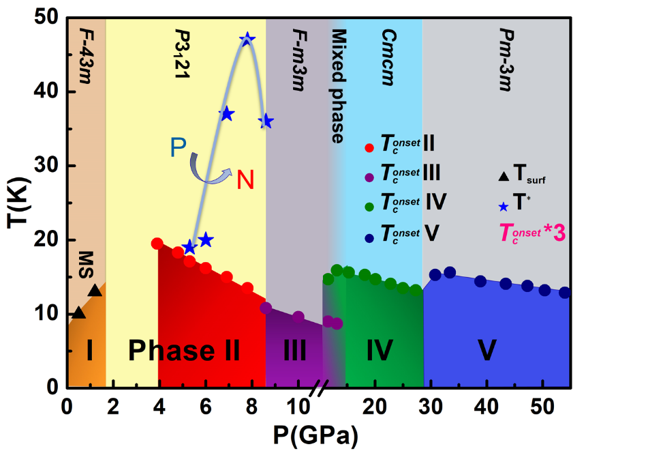Pressure-Induced Superconductivity in HgTe Single-Crystal Film - Wenge Yang
APRIL 30, 2022
Topological insulators (TIs) have attracted much attention over the last decade due to their novel electronic structures and topologically protected surface properties. HgTe was the first predicted and discovered 2D TI, and HgTe film is used widely for quantum Hall well studies and devices. It has unique properties, like band-gap inversion, carrier-type switch, and topological evolution depending on the film thickness modulation near the so-called critical thickness (63.5 Å). In contrast, its counterpart bulk materials do not have these properties at ambient pressure. However, a team of researchers led by HPSTAR scientist Dr. Wenge Yang has recently used pressure-tuning to discover much richer transport properties emerging in a 400 nm thick bulk HgTe crystal, to rival the unique properties of its thin-film counterpart. Moreover, they also discovered superconductivity in a series of the bulk HgTe’s high-pressure phases. These fascinating results are published in the article “Pressure-Induced Superconductivity in HgTe Single-Crystal Film” in Advanced Science.
A 400 nm thick single-crystal HgTe sample was subjected to hydrostatic pressure to explore the pressure tuning effects on its crystal and electronic structures using resistivity, Hall effect, and Raman spectroscopy. Combining crystal structure, electrical transport, and Hall coefficient measurements, a p-n carrier type switching was observed in the first high-pressure cinnabar phase in bulk HgTe. Superconductivity emerges after the semiconductor-to-metal transition at 3.9 GPa with the highest Tc onset ∼ 6.5 K, persisting up to 54 GPa, and crossing four high-pressure phases, increasing the upper critical field from 0.7 to 1.1 T. In Phases I and II, the competition of hole and electron carriers leads to carrier-type switching between temperatures of 19 and 47 K. Meanwhile, Phases III–V all behave as metal where only the electron carrier dominates the transport property. Density functional theory calculations confirm that a surface-dominated topologic band structure contributes these exotic properties under high pressure.

Caption: Temperature–pressure structure phase diagram of HgTe.
These results not only demonstrate that HgTe has excellent potential for exploring the relationship between topological structure and superconductivity but also the efficacy of pressure-tuning for lattice structure and electronic modulations compared to the thickness-dependent critical properties in 2D and 3D topologic insulators and semimetals.
拓扑绝缘体在过去十年中因其独特的的电子结构而成为凝聚态物理和半导体器件领域的研究热点。其与普通绝缘体相比,拓扑绝缘体在其界面或者表面存在导电的边缘态。二维HgTe是第一个被发现的二维拓扑绝缘材料,具有独特带隙反转、载流子类型和拓扑演化等独特的物理性质,因而被广泛用于半导体器件应用。然而,使HgTe表现出独特量子效应的输运性质及拓扑能带等至今未有深入的系统性研究,并且常压下HgTe未表现出像二维HgTe类似的物理性质。近日,北京高压科学研究中心的杨文革研究员团队与上海师范大学的秦晓梅教授团队合作的最新研究发现,在压力的调控作用下,HgTe单晶表现出丰富的晶体及其电子结构相变,并且在HgTe中首次发现了压力诱导的超导现象。相关结果以“Pressure-Induced Superconductivity in HgTe Single-Crystal Film“为题发表于Advanced Science。
